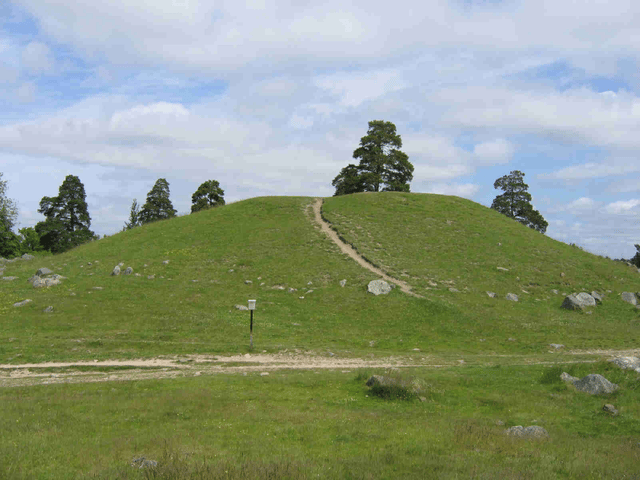Björn at Haugi

Björn at Haugi
Björn at Haugi ("Björn at the Barrow" from the Old Norse word haugr meaning mound), Björn på Håga, Björn II or Bern was according to Hervarar saga a Swedish king and the son of Erik Björnsson, and Björn ruled together in diarchy with his brother Anund Uppsale.
| Björn at Haugi | |
|---|---|
| King of Sweden | |
| House | House of Munsö |
| Religion | Pagan |
The account of the Hervarar saga
The Hervarar saga is an Icelandic work from the 13th century. At the end of a saga, a short chronicle of the Swedish kings from Ivar the Wide-Fathoming to Philip (d. 1118) has been appended, where Björn at Haugi is mentioned:
This account dates king Björn to the first half of the 9th century, as his nephew Eric Anundsson was the contemporary of Harald Fairhair.[2] Landnámabók mentions a Swede named Þórðr knappr who was one of the first settlers in Iceland and whose father was called Björn at Haugi.[2][3] Moreover, Björn and his court skald Bragi the Old are mentioned also in Skáldatal, where a second court skald also is mentioned, Erpr lútandi.[4][5]
The Icelandic scholar Jón Jóhannesson has argued that Björn at Haugi may in fact have been a petty ruler in Norway around the late 9th century, and is consequently not the same person as the Swedish king Bern (Björn) in the Vita Ansgarii (see below). The more original version of the Landnámabók seems to have contained two passages which associate Björn with persons from Sogn and Halogaland. Though evidence is not conclusive, Jóhannesson suggests that later tradition moved Björn from Norway (possibly Trondelag) to Svithiod due to certain legendary associations, or even since he had Swedish ancestry. The Icelanders may also have known about the Swedish Björn via the chronicle of Adam of Bremen (c. 1075), and assimilated him with the king in Skáldatal and Landnámabók.[6]
Björn in the Vita Ansgari
King Björn at Haugi has sometimes been identified with a king attested in Rimbert's (d. 888) Vita Ansgarii, which contains several passages about the first Christian mission in Sweden. Ansgar had previously worked in Denmark with the consent of King Harald Klak, a protegé of Emperor Louis the Pious. In 829, Swedish ambassadors arrived to the court of Louis in Worms. Among other matters they told the Emperor that many people in their country wished to embrace the Christian religion, and that their king endorsed the arrival of proper teachers. The Emperor summoned Ansgar and ordered him to go the land of the Swedes and investigate whether people were indeed prepared to accept Christianity. Thus Ansgar tread the journey together with his companion Witbert, sailing with a party of merchants. When about half-way, the ships were attacked by Vikings and those on board had to save themselves on shore. The missionaries lost the gifts and possessions they had carried, but nevertheless decided to proceed.[7] After traveling a long distance, mostly by foot, they arrived to the port of the kingdom which was called Birka, where they were friendly received by the king, whose name was Björn ("Tandem ad portum regni ipsorum, qui Byrca dicitur, pervenerunt, ubi benigne a rege, qui Bern vocabatur, suscepti sunt").[2] This king Björn was identified with Björn at Haugi[2][8] as early as in the writings of Langebek[2] who lived in the mid-18th century. As seen above, the identification is not universally accepted. Some scholars have called this Bern "king of Birka", but this has no foundation in Rimbert's writings, as Rimbert merely writes that Ansgar went ashore in Birka, which was in king Björn's kingdom.[9]
According to the Vita, King Björn discussed the arrival of the missionaries with his men, then announced that they were free to preach. Apart from the numerous Christian prisoners at the place, several people seemed interested in the new faith. To these belonged Hergeir, the chief of the port, who was a prominent adviser to King Björn. After having been baptized, he built a church on his personal land.[10] Ansgar stayed in Sweden for one and a half year and then returned to the Emperor's court in 831. Björn gave him a letter to bring to Louis, "written in the particular way of the Swedes", thus presumably with runic script.[11] In his stead an auxiliary bishop, Gautbert, was appointed for Sweden. However, his activity wax cut short several years later. An anti-Christian riot broke out, not supported by the king. Gautbert's nephew Nithard was killed, and Gautbert and his retainers driven out of the country. It is not explicitly said if Björn was still alive at the time.[12] The account indicates that the Swedish king had limited control over people.[13]
The Swedes in Vita Karoli Magni
The Vita is vague about the geography of Sweden, and there is no way of telling if the power of King Björn extended beyond the Mälaren Valley.[14] The Vita Karoli Magni, written around the time of Ansgar's visit, has a short description of the Baltic region: "There is a bay which stretches from the western ocean in eastern direction, of unknown length but with a breadth that may not exceed 150 kilometers, while it is less at many sites. Many people live around this bay, Danes and Swedes, which we call Norsemen, live both on the northern shore and all the islands in the bay. The southern coast is however inhabited by Slavs, Aesti and a number of other people".[15] This account, together with other sources from the 9th century, seems to indicate that the Danes and Swedes were the main Nordic peoples known to the continental authors, and that Björn's sphere of power was not merely local.[16]
See also
Early Swedish history